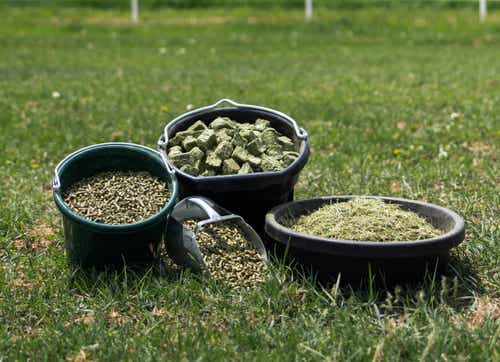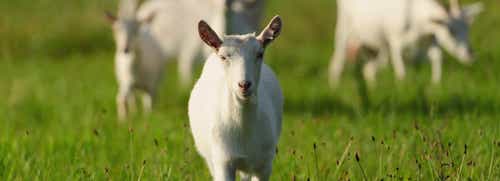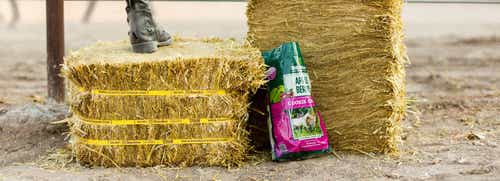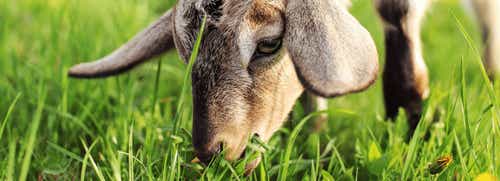
5 Common Horse Feeding Mistakes
Feeding horses should be easy, but unfortunately, it has become quite challenging for our modern horses. We have outlined 5 common mistakes that are made when feeding horses.
1. Not Feeding Enough Quality Hay
The horse has evolved as a grazing animal; forage plays a pivotal role in equine health. Horses are non-ruminant herbivores also known as a “hindgut fermenters”. Their digestive tract is made up of a simple stomach, small intestine and large intestine. The natural feeding habit of the horse is to eat small amounts of roughages, often throughout the day. Domestication has brought a change to this. Modern management practices of horses incorporate stabling, increased grain-based concentrate consumption, meal feeding and limited access to pasture. This has led to a myriad of problems by undermining the horse’s digestive capabilities. To ensure optimal health, horses must be given access to a high-quality fiber-based diet.
Forage contains all the essential nutrients required by horses:
- Water
- Energy
- Protein
- Vitamins
- Minerals
Horses require an absolute minimum of 1% of their body weight in dry forage per day; for a 1000 lb horse, this equates to 10 lb per day. A safer guideline is to provide horses with a minimum of 1.5% to 2.5% of their body weight in dry forage per day (15 to 25 lbs of dry forage per day for a 1000 lb horse) (Harris, 2016).
2. Feeding Too Much Grain
Grain concentrates and supplements should only be fed to compliment the forage being offered. If high-quality forage is being fed, most horses only require a low intake vitamin and mineral pellet (ration balancer pellet). As horses increase their workload or physiological demands, e.g. pregnancy or lactation, additional concentrate may be required. Excess grain can cause weight gain, increased gastric and hindgut acidity and may cause behavioral changes in some horses (Harlow et al., 2016).
3. Feeding Multiple Supplements Without Evaluating the Total Diet Impact
All equine diets should start with forage as the foundation and from here, additional concentrates and supplements may be added to balance the diet and/or add calories or protein. Other supplements are specific to joint health or gut health. It is important to read the ingredients list and make sure the horse is not being over supplemented with any single ingredient. Selenium, for example, is found in very low levels in forage, therefore, many horse owners feed an additional amount to compensate the horse’s requirement (selenium is 1.25mg per day for an 1100lb horse undergoing moderate exercise) (NRC, 2007). If the horse eats 20lbs of hay with a low selenium content (0.1 ppm), this equates to 0.9 mg of selenium, add 5lbs of a performance feed (selenium content 0.7ppm) which equates to 1.6 mg of selenium, then add an overall wellness supplement which contains an additional 0.8 mg selenium per 2 scoops. Next, add a hoof supplement with an additional 1mg of selenium per scoop and finally a coat health supplement with an additional 0.32 mg per cup (feeding rate). Our total diet now contains 4.62 mg of selenium. The maximum tolerable level of selenium for an 1100lb horse is about 20mg (NRC, 2007).
4. Not Feeding on a Regular Schedule
Horses are routine animals and can stress easily if not fed at similar times each day. Forage should be provided continually throughout the day to try and simulate grazing behavior if pasture is not available. Concentrate meals should be fed at the approximate same time each day to ensure horses do not become stressed. Irregular schedules will stress horses, and they may develop stall vices such as kicking, raking their teeth on the stall or cribbing. Digestive disorders can occur due to an overly hungry horse bolting (aggressively eating) its feed (Harris, 1998).
5. Not Enough Turnout
Horses are grazing, herd animals and they will cover large distances in a day, continually walking and grazing. Turnout provides opportunity for exercise. Horses out for 24hrs can walk up to 9.5 miles while horses out for 7 hours will only walk up to 3 miles (Sharpe & Kenny, 2019). Slow, continuous exercise that is provided by turnout keeps a horse’s joints flexible. During turnout, if horses can be with, or at least next to, other horses, it can decrease their anxiety levels as horses are social herd animals. Respiratory health can also be improved by increasing turnout time. Clean, fresh air is essential, especially in cases of airway or respiratory disorders (McIntosh et al., 2019).
These are just a few of the common pitfalls people fall into when feeding horses. The most important thing to remember, is that horses evolved as grazing animals and forage should always be the number one consideration in their diet.
References:
- Paul Sharpe, Laura B. Kenny (2019) Chapter 8 - Grazing Behavior, Feed Intake, and Feed Choices, Editor(s): Paul Sharpe, Horse Pasture Management, Academic Press, Pages 121-139.
- Bridgett McIntosh, Tania Cubitt, Sherrene Kevan (2019) Chapter 16 - Pasture-Related Diseases and Disorders, Editor(s): Paul Sharpe, Horse Pasture Management, Academic Press, Pages 311-328.
- Patricia A. Harris, Developments in Equine Nutrition: Comparing the Beginning and End of This Century, The Journal of Nutrition, Volume 128, Issue 12, December 1998, Pages 2698S–2703S.
- Harris, P & Ellis, Andrea & Fradinho, Maria & Jansson, Anna & Julliand, Véronique & Luthersson, Nanna & Santos, A.S. & Vervuert, I. (2016). Review: Feeding conserved forage to horses: Recent advances and recommendations. Animal: an international journal of animal bioscience. 11. 1-10.
- Harlow BE, Lawrence LM, Hayes SH, Crum A, Flythe MD. Effect of Dietary Starch Source and Concentration on Equine Fecal Microbiota. PLoS One. 2016;11(4).

